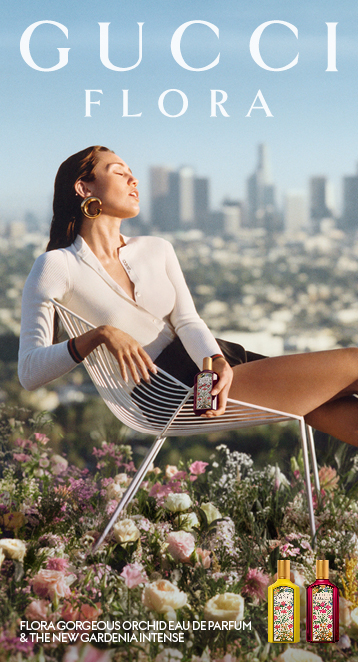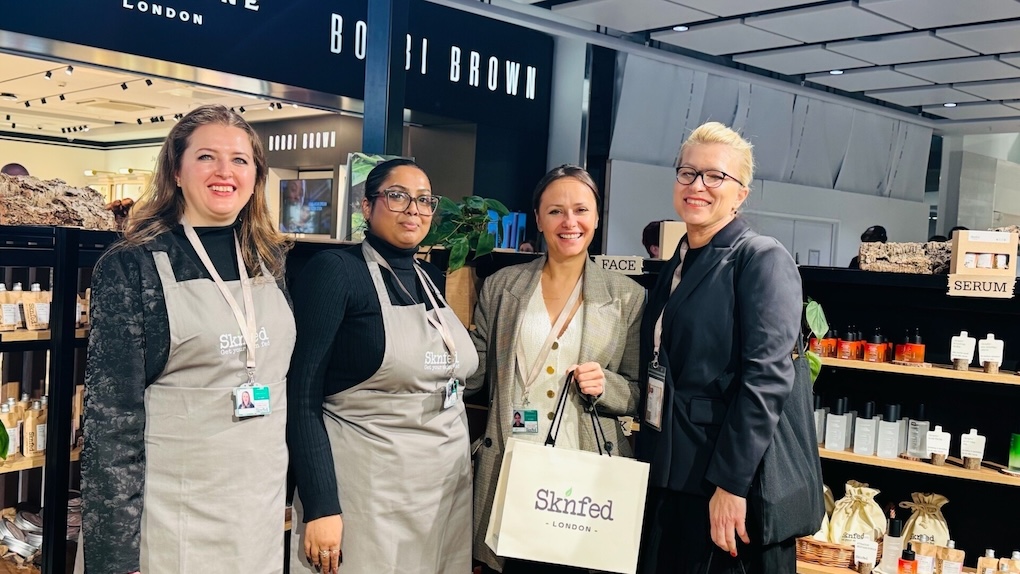To continue our series coinciding with last week’s TFWA World Exhibition and the forthcoming Trinity Forum (1-2 November), we present one of the best travel retail interviews you are likely to read. From its founding in 1983 to a record-breaking year in 2019, Dubai Duty Free was one of travel retail’s greatest success stories, posting uninterrupted annual sales growth and snapping up a seemingly endless string of management, marketing and operational awards. And then the wheels of the juggernaut came off as the COVID-19 pandemic forced the March 2020 closure of the retailer’s home airport, Dubai International.
After a steady but modest revival in 2021, this year has seen a hugely encouraging business acceleration with Q2 sales only -12.6% short of the comparative period in pre-pandemic 2019. Martin Moodie caught up with Dubai Duty Free Chief Operating Officer Ramesh Cidambi in Dubai recently to discuss the state of play. With additional comments from Dubai Duty Free Executive Vice Chairman and CEO Colm McLoughlin.
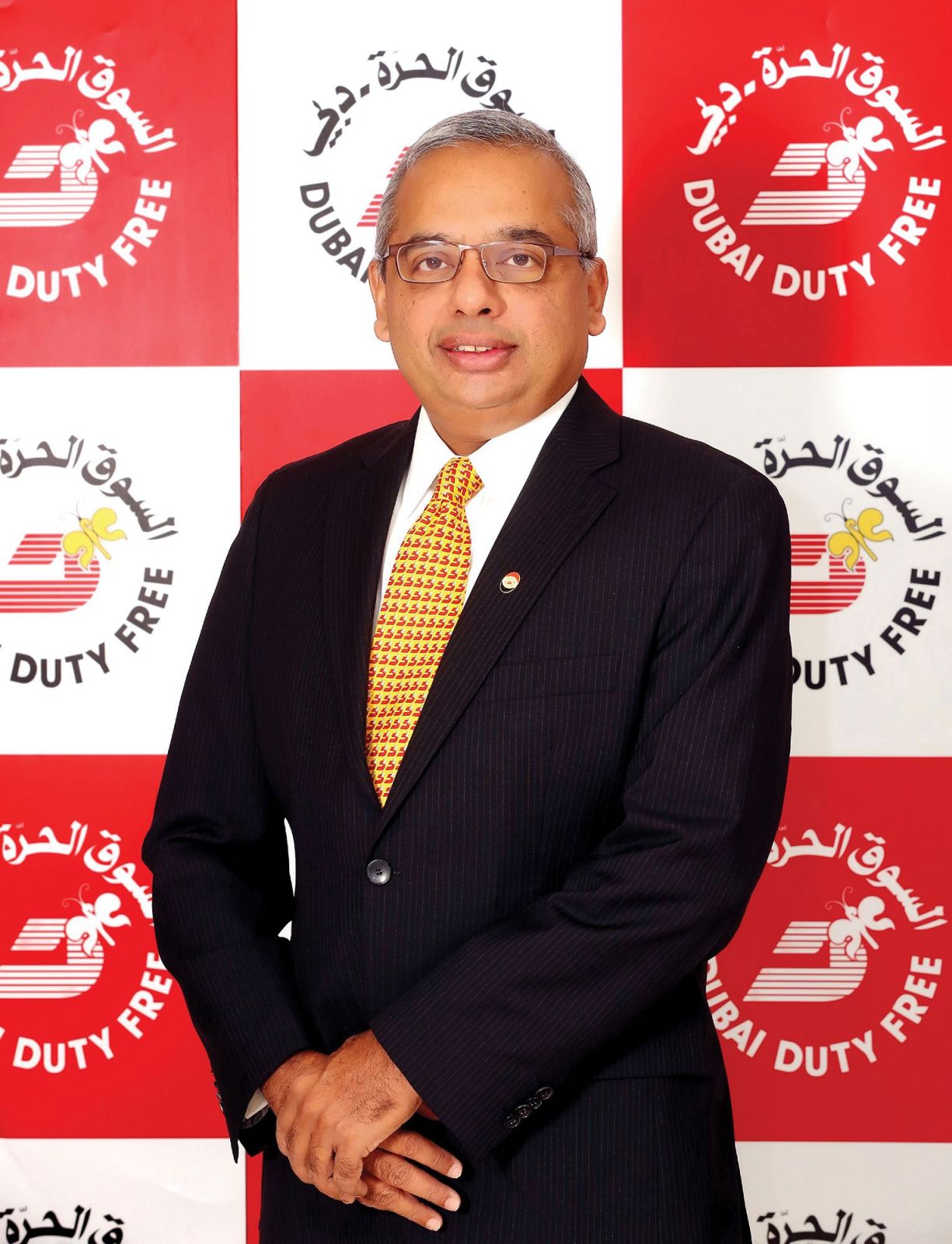
Ramesh Cidambi insists on looking forward rather than back as he assesses Dubai Duty Free’s increasingly encouraging recovery from the dark pandemic-ravaged days of 2020 (especially) and 2021. But the Chief Operating Officer and veteran of almost 34 years with the world’s biggest airport retailer in a single location says it is necessary to understand the astounding severity of the crisis to gauge the current performance and prospects. And he insists lessons must be learned by the company and its brand partners not just from the pandemic but from what has happened since business began to surge back.
“We started trading on the 20th of December 1983 and we were always so proud of the fact that we never stopped trading for one minute through various crises – two wars; SARS; the Iceland volcano crisis; numerous projects at the airport including the opening of terminals, and all the related construction and refurbishment,” he recalls. “We always managed to have the resilience and the robustness to be able to continue to trade, no matter what was happening.
“We had this uninterrupted 36-year double-digit compounded annual growth. In 2019 we were operating in a 24-hour airport with 1,000 flight movements a day. It was unimaginable that a) the airport would shut down; b) that the Dubai Duty Free shops would close; and c) that there would be a pandemic of this scale and that – this is my personal view – two of the major economies and population centres, Europe and the United Kingdom on one side and the United States on the other side would generally make a mess out of the initial handling of the pandemic. All this was compounded by the fact that the initial guidance from the World Health Organization was confused at best in March or April 2020. They were pushing back against travel bans. They were pushing back against masking, which was bizarre.”
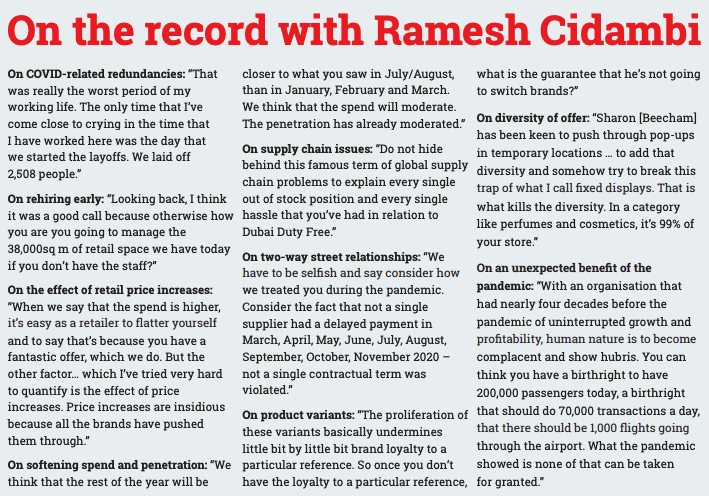
From 21 January 2020 when knowledge of the then unnamed coronavirus become widespread news internationally until Dubai International (DXB) closed down on 25 March, some 10 million passengers passed through what was (and still is based on 2021 numbers) the world’s busiest international airport.
“As leaders of the company, on the one hand we had thousands of our employees on the frontline and exposed to this virus,” Cidambi remembers. “And on the other we had a business that was starting to drop dramatically. And we all had this fear and anxiety about the disease. It was a management nightmare.”

Revenues nosedived through March 2020 and then came to a shuddering halt on 25 March as the government ordered the closure of the airport. Cidambi shakes his head at the memory. “When I think back and reflect, I can confidently say that there has been no other crisis like it in terms of the dual health and commercial impact.
“When we shut down the airport, we had a billion dirhams (US$272 million) in inventory on 25 March and then had the huge task of de-merchandising 180 shops, bringing stuff back, putting people on leave, all of that. And we were in an acute lockdown. We were extremely concerned about the disease. Our employees were falling sick though thank God we didn’t lose any employee on the payroll over the last two-and-a-half years.
“We were dealing with all that while trying to manage a frontline operation that had to be shut down. And then we were learning the protocols for reopening and working closely with the authorities here. Then we reopened on the 3rd of June 2020. I remind people that in a single day pre-COVID, Dubai International Airport would do about 220,000-230,000 passengers. In the whole month of June 2020 we did 105,000. It was a catastrophic fall in numbers, completely unprecedented.
“So it wasn’t as if we shut down on the 25th of March and simply reopened on the 3rd of June and it was back to business. It wasn’t.” Following an inspection by the authorities on 2 June 2020 to check protocols related to customer messaging, signage, social distancing measures and more, Dubai Duty Free was ready to go. It also had to decide which shops to open, get merchandise to them, and have masking and hygiene measures in place.
“Mona (Al Ali – Senior Vice President – Human Resources); Michael Schmidt (Senior Vice President – Retail); Zayed (Al Shebli – Senior Vice President – Loss Prevention and Corporate Security); Sinead el Sibai (Senior Vice President – Marketing); Sharon Beecham (Senior Vice President – Purchasing) and everybody in our management ‘dream team’ did a fantastic job to bring us to that point where on the 2nd of June, we passed inspection, and we reopened on the 3rd of June.
“Mona’s team did an amazing job because at one time we had hundreds of employees who had caught COVID. And then trying to decide what to do with 3,500-4,000 frontline employees when your shops are closed. At that time, Concourse A was closed. Concourse D was closed. Terminal 2 opened a bit later. The only real facility that was open was Concourse B. So we put people first on leave. Then eventually in September we laid off employees because we had too many employees in relationship to the retail areas that were open, and the revenue that we were earning and the payroll that we were burning through.
“That was really the worst period of my working life. The only time that I’ve come close to crying in the time that I have worked here was the day that we started the layoffs. We laid off 2,508 people.” Together with resignations, total staff numbers were reduced by around 3,300 by October 2020.
The rest of 2020 and first half of 2021 was a rollercoaster tide, affected by the COVID variants that emerged just as business would pick up. After a steady pick-up in passenger numbers from June to December 2021, the emergence of the Omicron variant dented business in January and February 2022. But since then, buoyed by strong attendance at the Dubai Expo in March, traffic and sales have rebounded well. While Russia’s invasion of Ukraine hit many markets dependent on high-spending Russian consumers, the crisis actually worked in Dubai Duty Free’s favour. With no barriers to arrival in place, many Russians opted to holiday in the emirate, some returning repeatedly.
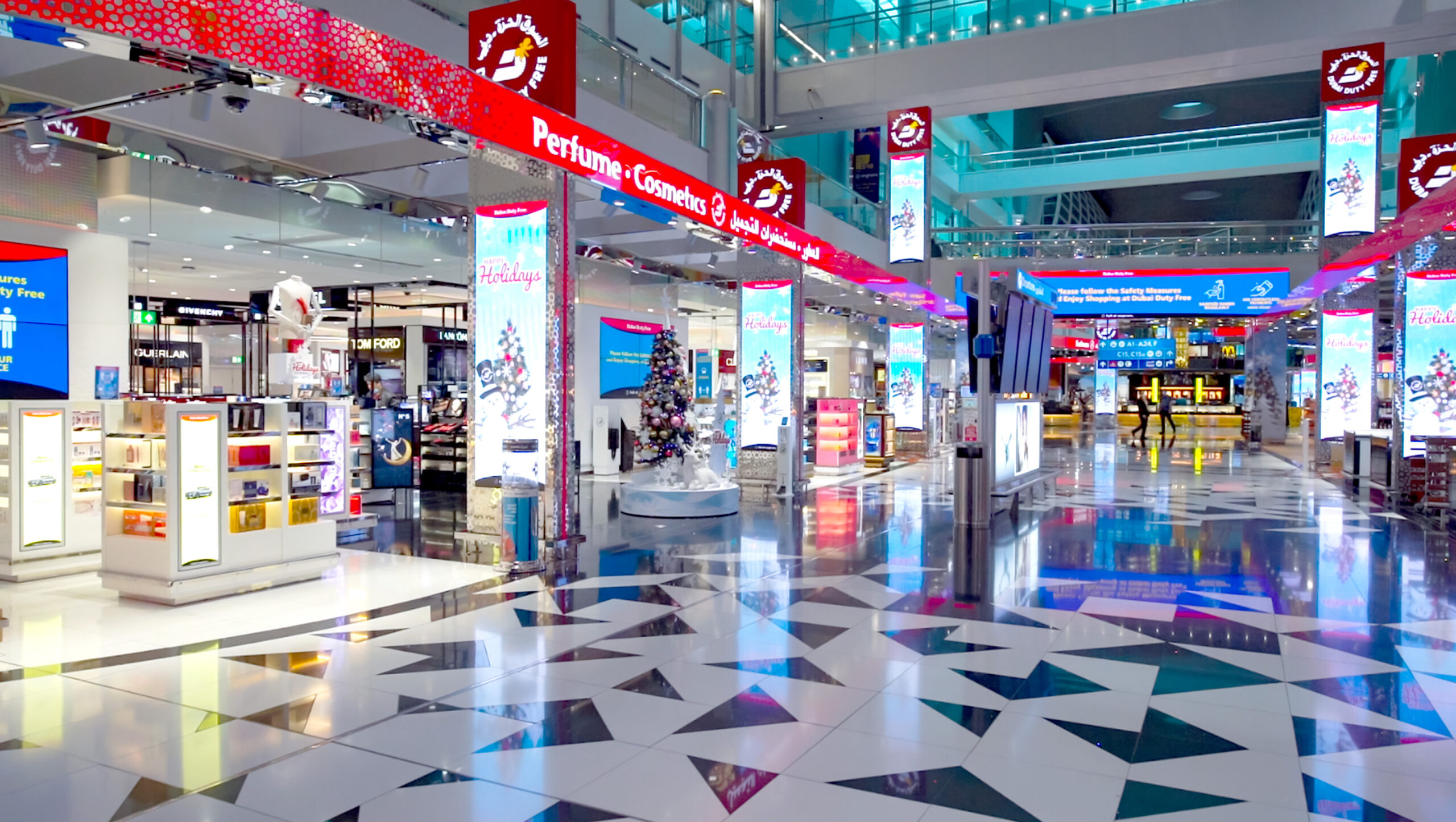
Proactive steps
At what point amid a still deeply uncertain, constantly evolving environment does a business leader slip out of defensive mode and step on the corporate and commercial accelerator? Early, in Dubai Duty Free’s case, Cidambi says. “From an employee point of view, Colm, myself and the leadership team took what was in retrospect a bold decision in September 2021 to bring back 1,500 of the 2,508 people that we had laid off;’ he comments.
“Again, Mona’s team did an amazing job of contacting all these people, finding out where they were, helping them to get tickets and accommodation and bringing them back because flights were still constrained in terms of capacity. There weren’t that many flights. And these people were doing various things at that point in time.
“We were always proud of the fact that we had employees from 45 countries. But that also meant we had laid off employees in 45 countries. Then we had the fact that Sharon, Michael and me managed inventory reduction from a billion dirhams to half a billion. And since then we have gradually built it up to about 650 million now. That, combined with the availability of the staff and the gradual opening of the retail areas is what really positioned us for the recovery.’
Better was to follow. In June 2021, Dubai Duty Free was given seven days’ notice to open 6,500sq m of retail space at Concourse D. Concourse A followed soon after. With Concourse B already open and parts of Concourse C trading, Dubai Duty Free was well and truly back in business, vindication of the bold decision to “pull the trigger early” on staffing, Cidambi says.
“In September and October oflast year, the outlook was not as clear but we were confident about the vaccines and their uptake – Dubai had more than 90% uptake. So that was a comforting factor. We knew that the Chinese would not be coming back in the near future but in spite of that we rehired essentially two-thirds of the people that we had laid off in 2021. Looking back, I think it was a good call because otherwise how you are you going to manage the 38,ooosq m of retail space we have today if you don’t have the staff?”

Or, in Dubai Duty Free’s case, no local labour force to call on. Impressively, the company brought back everyone on the same terms and conditions as before. Unsurprisingly, given both Dubai Duty Free’s reputation as a benevolent employer and the lack of job prospects in their home countries, there were some very excited people.
“They were extremely happy,” Cidambi says. “Every time Colm or I or any of the senior management went on the shop floor people would stop you and say, ‘Thank you. I’m happy to be back.’ By this time we had brought back about 1,800 employees from those whom we had laid off. About 300-350 of them had found other jobs and didn’t come back. I would say that 72% of the people whom we laid off have been re-employed. And of the people who resigned and left on their own volition in 2020 for a variety of reasons, we brought back about 25% of them if they wished to come back. So in that respect, I’m happy.”
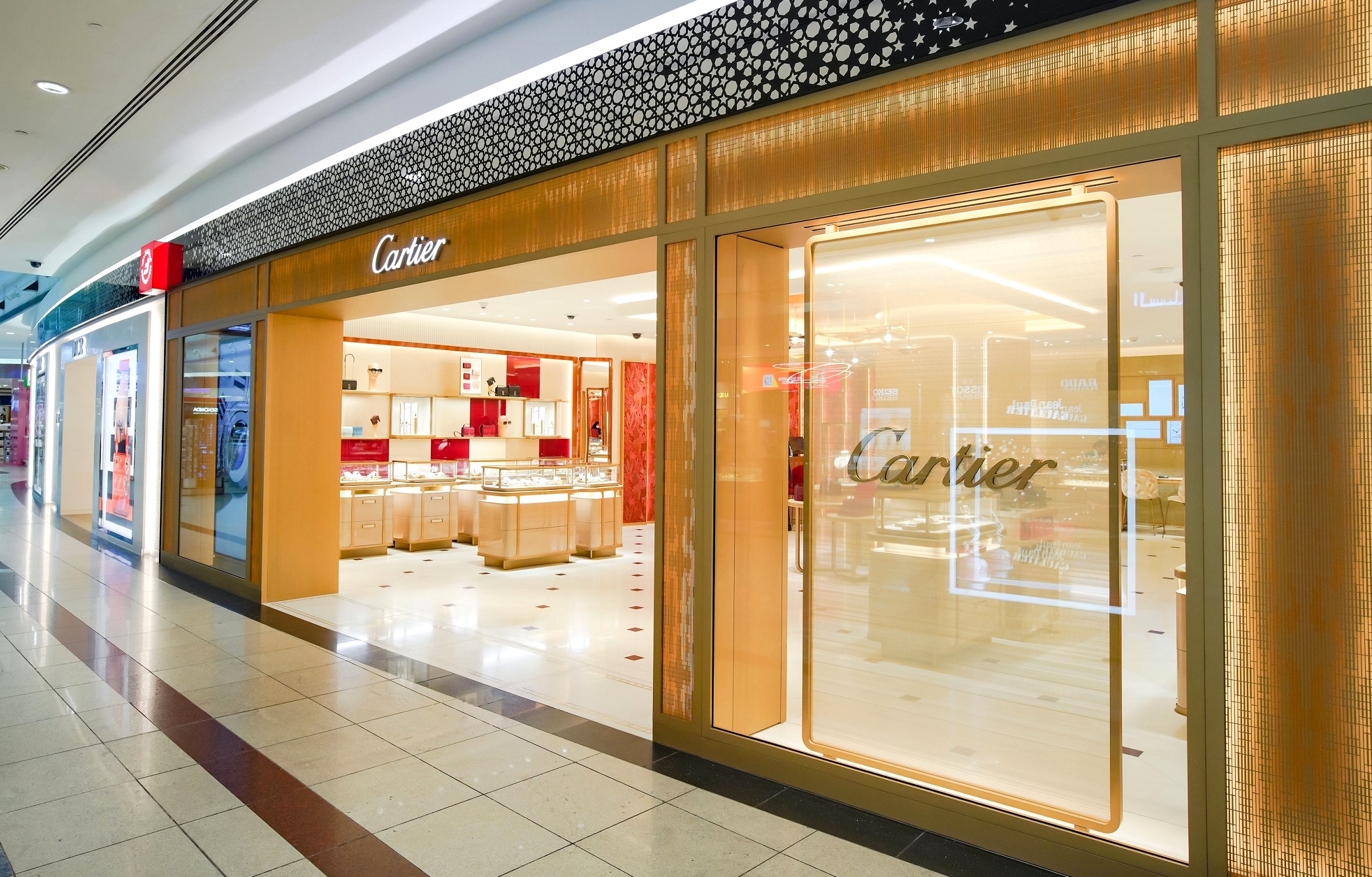
The trading results were cause for further satisfaction. “As a company we nearly broke even in 2020 and have been profitable from January of 2021. And for the first eight months of this year we are just down -18% on where we were in 2022. That is without any Chinese customers and in spite of the passengers being down -31%.”
However, Cidambi points to an interesting trend that suggests deeper analysis of basic top-line numbers is required to get an informed read on what might happen next. “The gap between the passengers being down and the sales being down is narrowing,” he explains. “For the month of August, the pax were down about -21% but the sales were down -15% whereas for the year to date it was -31% and -18%, so that is narrowing.”
Cidambi attributes that dynamic partly to a reduced average spend relative to a spike in 2021, when ATVs were even higher than in 2019. Several factors contributed to that, including the airport being less congested than in pre-pandemic times. “We had one-third of the passengers in 2021 as compared to 2019 so the service and experience was better. Maybe there was pent-up demand. And there was uncertainty about travel. So when people were travelling, they felt the desire to buy something more because you didn’t know when your next trip would be.
“But in 2022 the travel uncertainty is more or less gone. Many of us have made multiple trips in 2022. So we knew that the spend would reduce and go back to pre-crisis levels as would the penetration. The penetration in 2021 was much higher than in 2019. In January, February and March 2022, it was again higher, but now we are a single-digit percentage higher than 2019.”
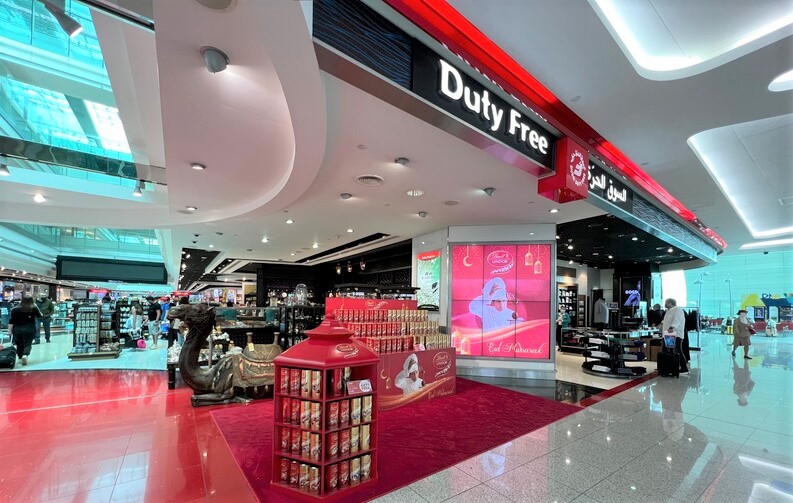
The impact of supplier price increases
Gross sales and average spend comparisons don’t, of course, factor in retail price increases, of which there have been many, driven by suppliers passing on their increased costs. Any increases in ATVs or overall sales have to be considered in that context, Cidambi explains.
“When we say that the spend is higher, it’s easy as a retailer to flatter yourself and to say that’s because you have a fantastic offer, which we do. We’ve done all this work in [luxury] fashion, for example. We have Louis Vuitton. We have Cartier. We have Dior. We have Gucci and Chanel from before and so on. And we have doubled that business compared to pre-COVID when it would have been 6% of our turnover. Now, it is 12-13%.
“So that’s a change to the retail offer which would have pushed the spend up. But the other factor which is harder to quantify and which I’ve tried very hard to quantify is the effect of price increases. Price increases are insidious because all the brands have pushed them through.”
To try to gauge the impact, Cidambi did an analysis whereby he looked at pricing across all common items that Dubai Duty Free sold in 2019 and 2022 during the first seven months [of each year]. “And if the exact same item – not a different reference, not a similar item but the exact same item – was sold, then I checked net prices against it. And the price increase across the categories contributed about 8%. That’s obviously a mixed bag. In areas like technology, very few items that you sell in 2022 were sold in 2019 because of obsolescence. But in liquor, in cigarettes and in other categories, it could be as high as 80% of the same items we have sold in both years.

“This exercise was for January to July 2022 when there were still price increases coming through, especially in categories like liquor where all the major suppliers – Diageo, Pernod Ricard, everybody – pushed price increases. And the price of gold went up. Gold contributes 7-8% of our business. So, 45% of the increase in sales of gold in 2022 as compared to 2019 is due to the higher price.”
In essence, part of the turnover increase is effectively a mirage, Cidambi says. That’s an important context in which to evaluate prospects for the balance of 2022 and into a 2023 certain to be marked by an inflationary environment. “How will that situation play out and at what point does the consumer push back and say ‘Listen, things are very expensive’? This is not the fault of the retailer nor the fault of the brands, but just an inflationary environment, where you have a continuous cycle of price increases.”
Already a kind of normalisation in customer behaviour is taking place, Cidambi reckons, pointing to August numbers suggesting a US$4 per departing passenger spend compared with US$8-9 for the first eight months. “We think that the rest of the year will be closer to what you saw in July/ August, than in January, February and March. We think that the spend will moderate. The penetration has already moderated.
“Already the airport is at 80% of the passenger loads that were there before. And that is a bit misleading because the airport has effectively pushed more flights and more pax into Concourse B. So if you look at the recovery of passengers by Concourse, Concourse B is 60-65% of our business. So if you are a passenger in Concourse B, you’re really back to near pre-pandemic levels, even if you say for the airport it’s -20%.
“So for the US passenger the experience in Concourse B today at seven o’clock in the morning would be exactly the same as it was in 2019. You won’t feel that -20% gap because of it and the lower level of congestion doesn’t exist in Concourse B, which is the majority of our business. If you are at Concourse A or Concourse D, yes the experience would be less crowded. But that’s not where the majority of the business is.”
Consumer pushback
However, even if retail price increases do account for 8-9% of the turnover gains, the overall result is still pretty satisfying, Cidambi says. “The thing with retail is that whatever you made you made,” he says with a smile. “So your shop is open 24 hours a day and through all the 24 hours you need to keep generating revenue. So, yes, now we have made this extra 8-9% revenue – fantastic. The problem really is whether there is an inflection point where the consumers push back on pricing.”
It’s a key question, he argues, and one that will also resonate once the supply chain bottlenecks are released leading to more product being available. “And then in the first or second quarter of next year what are you looking at? You’re looking at an economy that is softening in several countries. High inflation. High-ish interest rates, a strong currency [the US Dollar] which affects us in every important market, the United Kingdom, Europe, the Indian subcontinent. All of them will suffer if the dollar continues to remain strong in terms of home markets. And product availability starting to get better and better.
“So then do you do aggressive pricing? Do you do aggressive promotion? We haven’t had any success with it but we at least feel that we have a responsibility to tell some of the major suppliers, at this point in time you seem to have the leverage as the brands because you have supply constraints, relatively high demand, pricing power and the ability to increase prices.
“But that’s not necessarily a permanent feature. At some point in time this can change for a variety of reasons, either an economic crisis or semi-crisis or an increase in supply. The brands will say, of course, that supply can’t be increased suddenly and that if you have a shortage of aged whiskey, where are you going to get it from? We understand that. But we also caution that the combination of supply chain problems and relatively high demand that you’re seeing now also causes the brands to sometimes overestimate what the true demand is. So, I think Q1 and Q2 of next year will be quite interesting.”
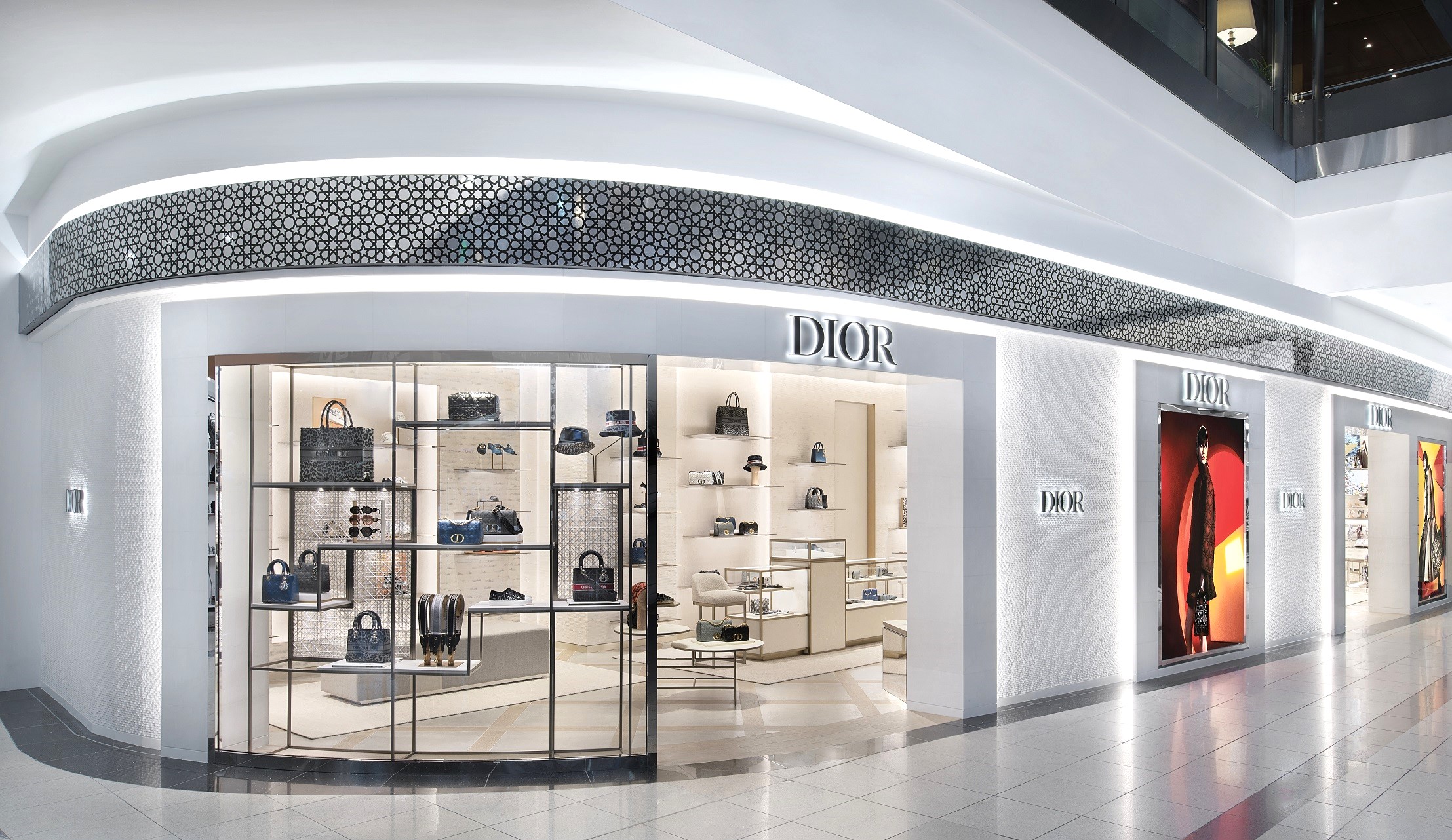
To help the process for itself and its supplier partners, Dubai Duty Free pulled forward the budgeting process for 2023. “Bernard [Creed, Senior Vice President – Finance] did a great job of bringing forward the process, getting to a point by the middle of September where we have a reasonable view on 2023, assisting the brands as much as possible in terms of forecasting and giving as good information as possible,” says Cidambi. “To that extent, I’m really proud of the technology and the platform that we have to provide the brands with the best possible data on inventory and sales. And I’m really proud about the expertise of Sharon and her team in terms of forecasting.
“We said to ourselves that whatever we suggest in September or October might happen for the first quarter of 2023 is what the brands would put in their forecasts and in their own production planning and supply chain processes. So, we said, let’s try and bring forward that date. Try to have as much high-quality information as possible in September and early October and then that helps you for January/February. Then once you get through January and February, then you recalibrate. The brands felt like the guidance we gave some of them in October/November last year was more conservative than what really happened in January, February and March 2022. We accept that but say that if you overshoot in terms of demand and you have problems in inventory, both parties will have to take responsibility for that.
“It’s not only about the brands because what the brands do is also based on guidance that we give. If I say to them that we’ll have 28 million passengers next year and 6.6 billion Dirhams in business, then I’m putting a number out there, right? What we are saying is, try and get to that number and get to the basis early. Watch what the situation is, see how things develop in November/December and then be a little bit more flexible and a little more agile in January and February if things either go south and things really soften or things continue to boom and you still overshoot your numbers. Because both are a problem. Overshooting is a problem and undershooting is a problem.”

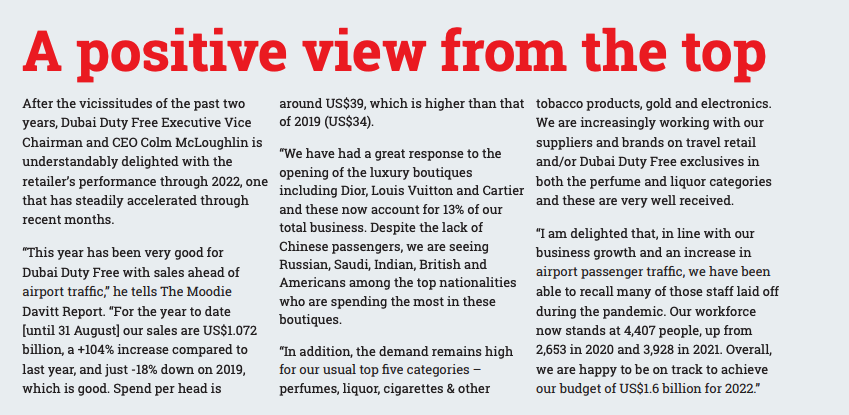
The shift of risk from supply side to retailer side
With so many problems around the supply chain, including pressures on bottling and packaging procurement, how tough has it been to get stock on shelf? As always, Cidambi’s is a measured reply that takes in the wider picture.
Yes, supply chain issues exist in categories such as fragrances, watches, spirits, confectionery and technology, he admits. “But they are not problems of a magnitude of being what I would call a business risk in a true sense – not in the sense that it’s going to dramatically impact your P&L. It’s not going to dramatically impact your balance sheet. It’s not that scale of a problem.
“If I consider the catastrophic fall in passenger numbers that happened in 2020 to supply chain problems in 2022, they’re not of the same scale. What I am saying and what I said in October and November last year was that the risks in terms of running retail business were shifting from the demand side risk to a supply side risk and that is exactly what happened.
“As a retailer, you are in a situation where there was inconsistency in terms of availability of items; consumers switching between brands; and more difficulty in terms of forecasting and understanding where the true demand lies for a particular line of items.
“One of our problems and where we have been pushing back and making a very strong point with the major groups is this. Do not hide behind this famous term of global supply chain problems to explain every single out of stock position, every single hassle that you’ve had in relation to Dubai Duty Free.
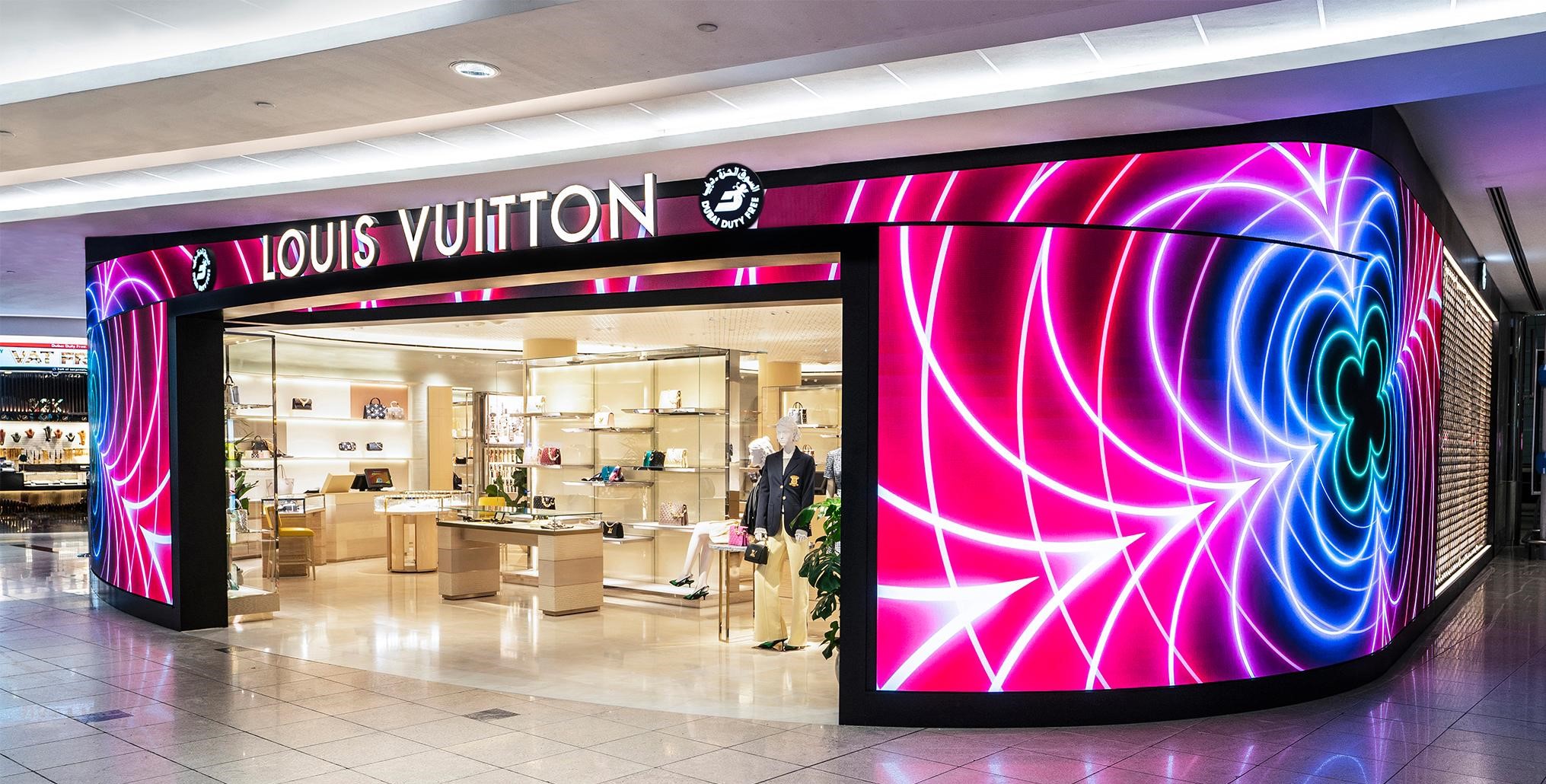
“Because we genuinely believe that it is a composite problem. We know that there are problems in availability of stock at Dubai Duty Free because the teams on the ground from the brands didn’t do a good enough job of understanding what the hell was going on in our business.
“We believe that we are one of the best retailers in terms of telling you what is happening in our business. I can confidently put my hand on my heart and say that the quality of the information that you will get from us as a brand in terms of how your brand is performing in our business is second to none – or at least we are very good. So, in that environment, if your team on the ground didn’t get their act together or you under-resourced them or you removed the budget from the travel retail business or you cut back on manning, or you moved the team from Dubai to London or whatever the hell that they did – that all got them to get caught out in a situation where demand was really stronger than the initial projections.
“Then you had, of course, these supply chain problems, which I am not discounting – caps are not available, bottles are not available, freight constraints with a ten-fold increase in the price of freight and all that. We understand.”
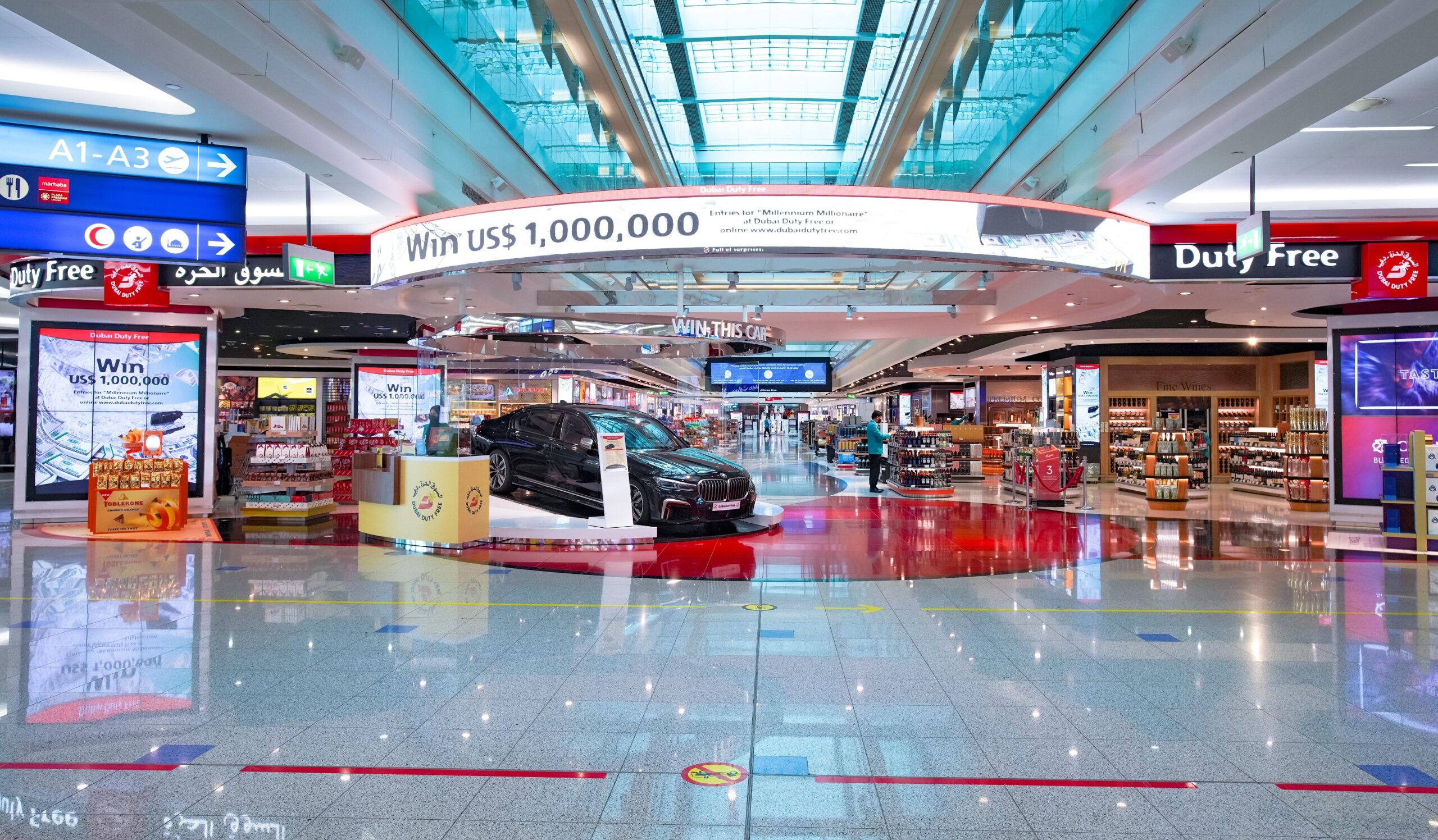
A two-way street?
Cidambi raises the related subject of allocation. With stocks in short supply, what is a brand’s allocation formula? Who are they giving the stock to? “We have to be selfish and say consider how we treated you during the pandemic. Consider the fact that not a single supplier had a delayed payment in March, April, May, June, July, August, September, October, November 2020 – not a single contractual term was violated.”
“We managed to reduce the inventory through cooperation with the suppliers who cooperated. Some suppliers didn’t cooperate. We dealt with that. We kept our end of the bargain during the crisis. So how are you treating us in 2022 in terms of allocation of stock? I don’t want to sound critical of suppliers and I would say that Sharon and the team did manage to consistently make sure that Dubai Duty Free was high on the priority list. We don’t know how high, but we would tend to believe that we were high up.
“So, the supply chain problem is a composite problem of poor work on the ground by the teams, genuine problems with availability and logistics and freight and allocation. But in the end, it should not be a position where the retailer is worried more than the brand about the supply chain problems. Because at a certain point, I can take a completely cynical view and say ‘Listen, if product A is not available and product B is sold from another supplier, good luck to the guy who’s supplying product B. Consumers bought an item and go on. I am not really suffering.”
That is a cynical view, Cidambi admits, and one the company would prefer not to adopt. “But if the suppliers don’t really get their act together to the extent possible, then you do have dissatisfied customers. You do have people that get upset that products are available then not available, and so on, which eventually harms the retailers.”
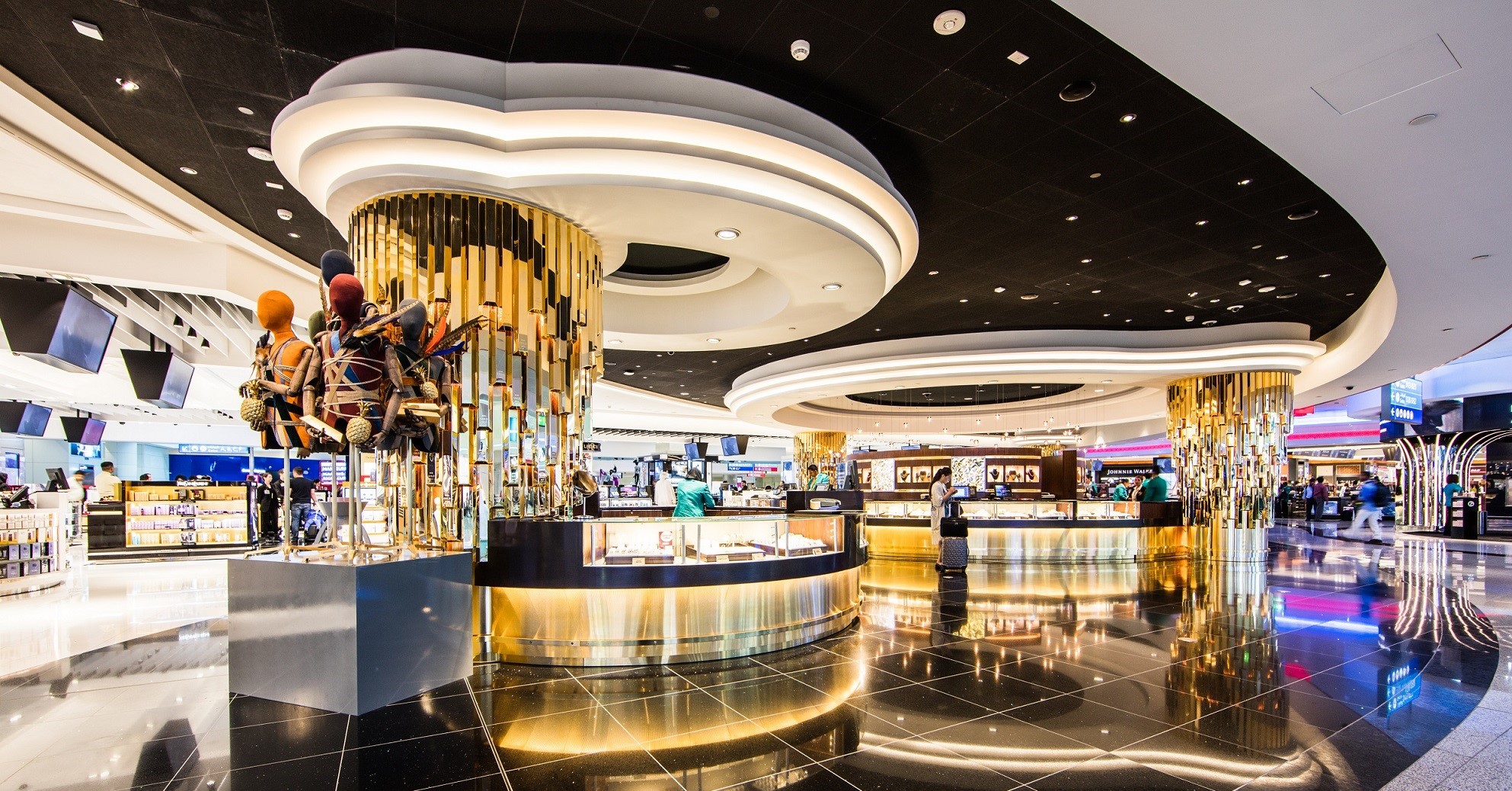
Too many variants – and we’re not talking COVID
But surely while consumers might shift between one single malt whisky or gin and another, would an ardent Johnnie Walker Black or Chivas drinker shift? Would a Marlboro smoker? Unlikely. Rather than talk specifically about any of those examples, Cidambi turns the conversation to what he sees as brand dilution by many suppliers caused by the proliferation of variants.
“It’s one of the things that we have always been worried about in the liquor category. At every Cannes and every meeting the suppliers talk about innovation being fantastic… but the proliferation of these variants basically undermines little bit by little bit brand loyalty to a particular reference. So, once you don’t have the loyalty to a particular reference, what is the guarantee that he’s not going to switch brands? And then what is the guarantee then that he’s not going to switch categories and drink tequila instead of whisky? Pre-COVID, I believed there was too much of a push to premiumisation and too many variants in that particular [Scotch whisky] category, which I believe might have eroded some of the loyalty.”
Talking about the tobacco category, Cidambi points to a rising surge in traditional cigarette smoking alternatives, such as heat not burn devices, which are competing with long-established brands. The ‘non-combustible’ tobacco category has now reached 12-13% of total tobacco sales from zero in just three to four years, two of those years ravaged by the pandemic.
“For us, by any metric, it’s a positive development. It’s an attractive product. It looks good. And there is some sort of a case that you could make saying that it’s healthier than burning paper and ingesting the tar and all of the chemicals when you’re smoking. So, for us, it’s a net positive.”

The numerous out of stocks have distorted the dataset through 2022 and make forecasting for 2023 more difficult, Cidambi says. In response, I ask whether Dubai Duty Free could adjust what he sees as a mounting supplier-slanted imbalance in the traditional relationship by either developing more in-house brands or championing challenger brands. After all, DFS did do brilliantly with Camus and Nina Ricci during its extraordinary growth period serving Japanese shoppers from the mid-1960s to the late 1980s.
Cidambi gives a typically considered and contextual reply. “If you see the evolution in the major categories – take cigarettes, perfumes, cosmetics, fashion and let’s say to a lesser extent, confectionery and delicatessen – what has happened over time is what we call ‘custom fit-out’ or what the brands call ‘fixed visual displays’ have occupied greater and greater percentages of the retail areas that we have.

“The brands have invested in terms of the custom fit-out and the presentation of the products because the fit-out, the merchandising and the consumer experience is much better. So overall, by any metric, it’s a positive development.
“The difficulty has been that the real estate which is really flexible from a retailer’s point of view has gradually dwindled to next to nothing in these categories. So, pushing back on that and creating space for challenger brands or whatever brand that you want to champion is a) difficult purely from an operational perspective and b) the merits of strongly preferring a brand or brands… in terms of how fair that is are not clear to me.
“So, we generally are agnostic about one brand versus the other from the point of view of preferring or not preferring someone. What we want to do is to the greatest extent possible reflect what the base demand is for a particular brand. And that is really derived from the work that is done on those brands in the domestic market and to some extent in other travel retail markets. The demand really originates in the domestic market in our view and flows to travel retail.
“So, we don’t want to be aggressive in that sense and take a position that Dubai Duty Free will somehow take a brand and make it massive. We are not in the business of that. We are in the business of reflecting what the customers’ tastes and desires are and providing them as much choice as possible, which is somewhat compromised by the reality of the real estate that the brands occupy. So, that’s the kind of dilemma that we have.”
Maintaining diversity
One of the historic attractions of the Dubai Duty Free offer is its diversity of brand line-up across many categories. If one looks at, say, rum – an arguably underrepresented sector in duty free – Dubai Duty Free offers an impressively manifold selection. The same could be said of multiple other categories. How does the company balance the demand for (and demands of) the big houses vis a vis smaller brands? And will Dubai Duty Free try to maintain that eclectic heritage?
“I wouldn’t say that we are necessarily as fantastic at it as we would like to be but we want to try,” Cidambi responds. “One of the things that Sharon has been keen to push through is pop-ups in temporary locations and through whatever means we have to add that diversity and somehow try to break this trap of what I call fixed displays.
“That is what kills the diversity. In a category like perfumes and cosmetics, it’s 99% of your store. So, what diversity are you going to have? Unless you have a pop-up location. So, that’s what we have been pushing for. We say to a brand ‘We’ll give it to you for three or four months, try it out.’ Then you have some hope. In airports, the lead times in terms of changing a unit, removing a wall bay and putting in a new one are so long and the processes are so bureaucratic that the reality is from the time you decide to do something and you see the evolution of it, it can be six months or more.”
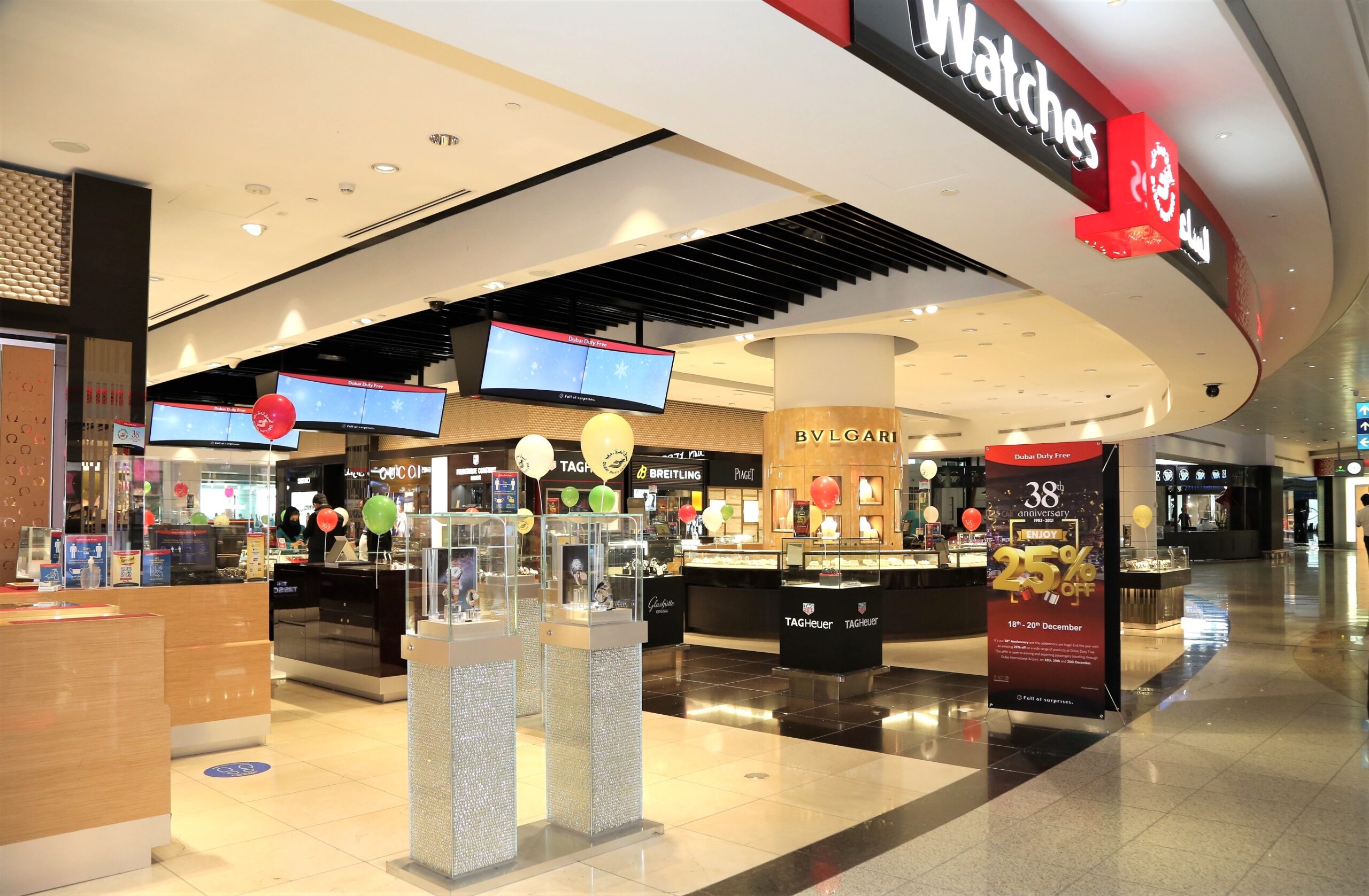
Does he believe Dubai Duty Free will emerge from the trauma of the pandemic as a better retailer? “I think so,” says Cidambi. “The reason I say that is that with any organisation that had nearly four decades before the pandemic of uninterrupted growth and profitability, human nature is to become complacent and show hubris. You can think you have a birthright to have 200,000 passengers today, a birthright that should do 70,000 transactions a day, that there should be 1,000 flights going through the airport. What the pandemic showed is none of that can be taken for granted.
“You learn that things are never as certain as you think they will be and there’s a real possibility of volatility. From that point of view, it shakes you out of that complacency.” The same applies, Cidambi contends, to staff, whether they were laid off and rehired or kept their roles through the long and difficult period of commercial crisis. “They understand that you can’t take employment for granted and that you have to be keen and energised and active in whatever your role is because you could have an event like this pull the rug from under your feet.
Dream team united
“So I think the complacency amongst the employees and the team is less and from the point of view of profitability and of cutting out fat, we are definitely a leaner organisation. The pandemic was not the most ideal way to get leaner and it’s not recommended and you don’t wish it on any organisation but the reality is that you are leaner as an organisation.
“From the point of view of the team, from Mr. McLoughlin’s leadership and my role in terms of supporting the team and the structure that we have, we have never been as united and as cohesive as a group before as compared to previous times and with Michael, with Sharon, with Zayed, with Bernard, with Mona, Sinead, Salah (Tahlak), all of us, we share a special bond because of what we went through in 2020 and 2021.
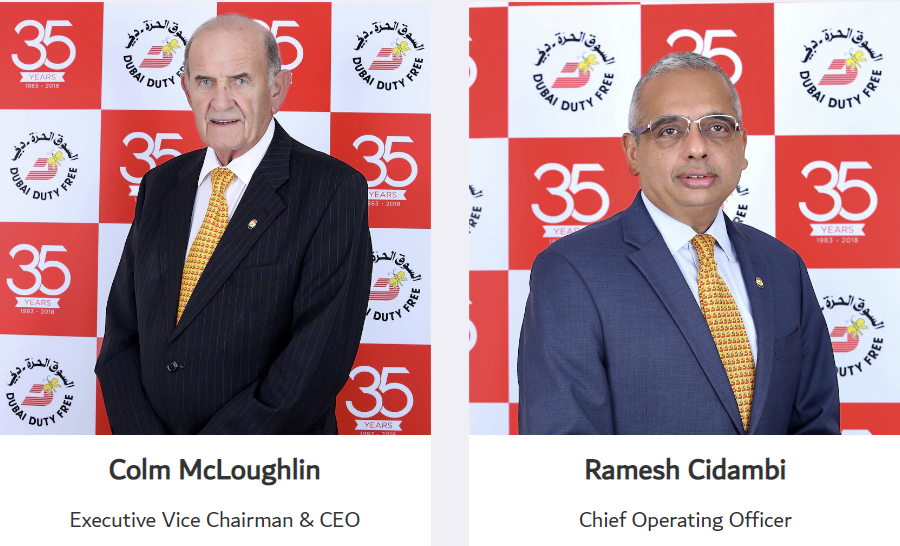

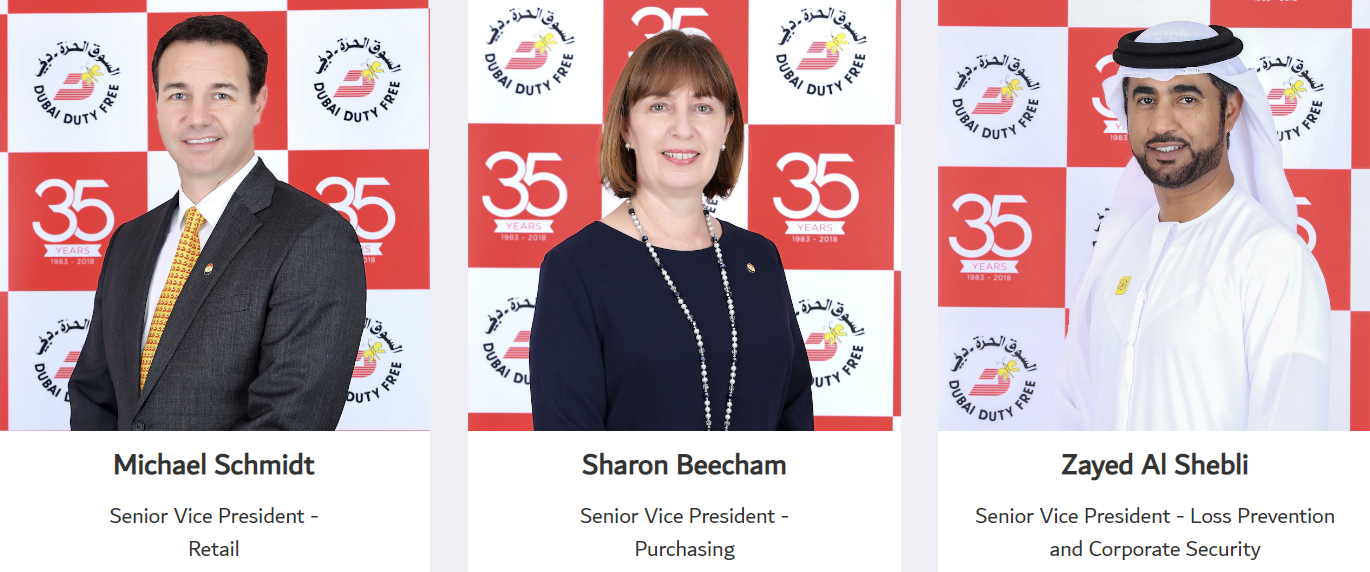
“I’m hoping that the crisis and the effect that it had in terms of teamwork and cohesion remains. Human nature being human nature, as they say, makes a philosopher of everyone for a day. So maybe in one year’s time or two years’ time, this is forgotten and people will go back to their normal behaviour, but as an organisation, as a team, we think we are better.
“We did some work, for example, in the digital space [ecommerce now represents a high single-digit share of Dubai Duty Free’s from just 1% pre-pandemic -Ed] and things like that which will hold us in good stead in the future. We continued to invest in the retail offer in 2020 – to do renovations and projects like that back then was a brave step. We did all of that so I think overall we are better as an organisation and we will hopefully continue to have the momentum to resist the economic forces and the headwinds that we might see in 2023. Not everything, as we know, is under our control. But we are better positioned in terms of overcoming those.”
As a long, fascinating and refreshingly candid interview reaches an end, I ask Cidambi if he has any wider message to the travel retail industry at large. “My single overarching message to them would be don’t get too flattered by what you saw in 2022 in terms of demand and keep that in mind when you’re thinking of 2023 and an environment of rising prices,” he says with a wry smile. “So a little bit less self-congratulation about 2022 and a greater sense not of scepticism but of alertness in terms of 2023.”







